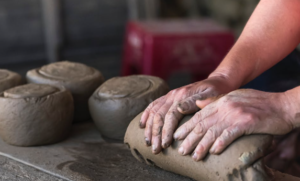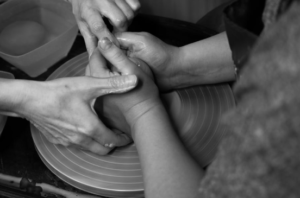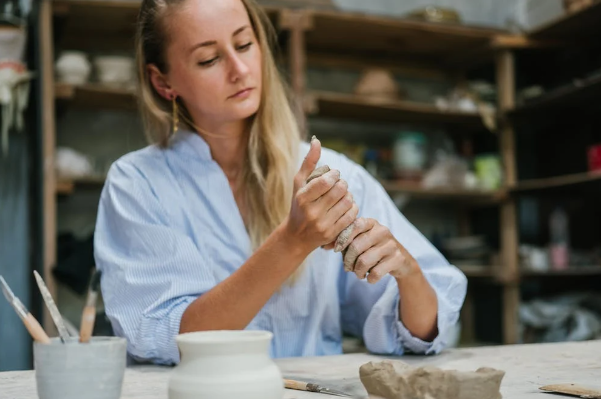Table Of Contents
- 1 Diving Into the World Of Clay Sculpting: Essential Tools For All Levels
- 1.1 The Advantages of Clay Sculpting:
- 1.2 Must-Have Tools for Every Sculptor:
- 1.3 Choosing the Right Tools:
- 1.4 Mastering the Fundamentals of Clay Sculpting with Basic Tools
- 1.5 1. Preparing Your Clay:
- 1.6 2. Creating the Basic Forms:
- 1.7 3. Shaping and Refining:
- 1.8 4. Joining Clay Pieces:
- 1.9 5. Adding Texture and Details:
- 1.10 6. Finishing Touches:
- 1.11 Enhancing Your Clay Sculpting Skills with Advanced Techniques
- 1.12 1. Creating Textures and Surface Variations:
- 1.13 2. Shaping and Detailing with Precision:
- 1.14 3. Assembling Complex Forms and Structures:
- 1.15 4. Enhancing Functionality and Versatility:
- 1.16 5. Expressive Decoration and Personalization:
- 1.17 6. Pushing the Limits of Clay Sculpting:
- 1.18 Sharing Your Clay Sculpting Journey and Beyond
- 1.19 1. Sharing Your Creations:
- 1.20 2. Preserving Your Creations:
- 1.21 3. Expanding Your Artistic Journey:
Diving Into the World Of Clay Sculpting: Essential Tools For All Levels
Welcome, aspiring sculptors! Today, we embark on a captivating journey into the realm of clay sculpting. Whether you’re a seasoned artist or a curious beginner, this session will equip you with the knowledge and understanding of basic clay sculpting tools, essential for bringing your creative visions to life.
The Advantages of Clay Sculpting:
- Versatility: Clay offers a boundless canvas for creative expression, allowing you to mold it into virtually any shape or form imaginable.
- Accessibility: Clay sculpting is a relatively affordable art form, with readily available materials and tools suitable for all budgets.
- Relaxation and Mindfulness: The tactile experience of sculpting can be deeply therapeutic, promoting calmness and reducing stress.
- Skill Development: Clay sculpting hones your hand-eye coordination, fine motor skills, and creative problem-solving abilities.
- Personal Expression: This art form allows you to express your individuality and emotions through unique and tangible creations.
Must-Have Tools for Every Sculptor:
- Rolling Pin: This essential tool helps you flatten clay into even sheets for creating various shapes and textures.
- Sculpting Knives and Blades: Utilize these tools for cutting, trimming, and shaping your clay with precision.
- Needle Tools and Ball Styluses: These versatile tools are ideal for adding delicate details, carving intricate patterns, and creating small holes.
- Sculpting Sponges: Keep a damp sponge handy to smooth out rough edges, blend seams, and remove excess clay residue.
- Texture Mats: These mats help you imprint various textures onto your clay surface, adding depth, dimension, and visual interest to your sculptures.
- Scoring Tool: This tool creates rough textures on the clay surface, enhancing adhesion between different clay pieces.
- Water Container: Keep a container of clean water readily available to keep your hands and tools moist while sculpting.
-
Additional Tools for Advanced Techniques:
- Ribs: These tools are ideal for smoothing large areas of clay and creating curved surfaces.
- Slip Brushes: These brushes are perfect for applying slip, a thin clay and water mixture, to improve adhesion when joining clay pieces.
- Modeling Tools: These tools come in various shapes and sizes and are ideal for adding specific details and textures to your sculptures.
- Wire Armatures: These wire structures are used as internal support for larger sculptures, providing stability and preventing them from collapsing.
Choosing the Right Tools:
Consider your skill level and the type of clay you’re using when selecting your tools. Beginners might start with a basic kit, while more experienced sculptors might invest in specialized tools for advanced techniques. Remember, quality matters! Invest in well-made tools that will last and provide you with optimal control and precision during your sculpting journey.
Ready to embark on your clay sculpting adventure? In the next session, we’ll delve into fundamental clay sculpting techniques, empowering you to transform that lump of clay into a unique masterpiece. Stay tuned!

Mastering the Fundamentals of Clay Sculpting with Basic Tools
Welcome back, budding artists! In this session, we’ll dive into the fundamental techniques of clay sculpting, using the basic tools we explored earlier. By mastering these essential skills, you’ll be well on your way to creating stunning sculptures.
1. Preparing Your Clay:
- Wedging: This process removes air bubbles from the clay, ensuring a smooth and even consistency for sculpting.
- Kneading: Knead the clay to soften it and make it pliable, allowing for easier manipulation and shaping.
2. Creating the Basic Forms:
- Pinching: This beginner-friendly technique involves pinching the clay with your fingers to create simple forms like bowls, cups, or figurines.
- Coiling: Roll the clay into long, snake-like coils and join them together to build larger and more complex shapes.
3. Shaping and Refining:
- Use your fingers, sculpting knives, and sponges to refine your clay creation. Smooth out rough edges, add details, and create expressive features.
- Experiment with different tools to discover their unique functions and achieve the desired textures and effects.
4. Joining Clay Pieces:
- Use the scoring tool to create rough surfaces on the clay pieces you want to join.
- Apply a thin layer of slip (clay and water mixture) to both surfaces for better adhesion.
- Press the pieces firmly together and smooth out the seams with a damp sponge.
5. Adding Texture and Details:
- Use the needle tool and ball stylus to create delicate details like eyes, mouths, or patterns.
- Texture mats provide a simple way to add interesting textures to your clay surface.
- You can also use found objects like leaves, shells, or buttons to create unique imprints and textures.
6. Finishing Touches:
- Smooth out any remaining imperfections with a damp sponge.
- Allow your creation to dry completely before decorating it with paint, glaze, or other embellishments.
Remember, practice makes perfect! The more you use your tools and experiment with different techniques, the more comfortable and confident you will become in bringing your creative visions to life. With dedication and practice, you’ll be sculpting amazing pieces in no time.
In the next session, we’ll explore advanced techniques and tips to help you refine your sculpting skills and achieve even more impressive results. Stay tuned for more exciting adventures in the world of clay sculpting!

Enhancing Your Clay Sculpting Skills with Advanced Techniques
Welcome, experienced sculptors! As you progress in your clay sculpting journey, it’s time to elevate your skills and explore advanced techniques that will transform your creations into masterpieces.
1. Creating Textures and Surface Variations:
- Imprinting Objects: Use natural objects like leaves, shells, or stamps to create unique textures and patterns on your clay.
- Layering Clay Colors: Combine different clay colors to create a variety of textures, such as marbling or faux fur.
- Embossing and Carving: Employ carving tools to add realistic details, create depth, and add texture to your creations.
2. Shaping and Detailing with Precision:
- Fine-tipped Sculpting Tools: Use fine-tipped sculpting tools, such as needle tools or ball styluses, to add delicate details, refine features, and create intricate patterns.
- Creating Holes: Use a needle tool to create holes for adding decorative elements, such as beads or pendants.
- Creating Organic Forms: Use a variety of techniques, such as coiling, pinching, and sculpting, to create organic and lifelike forms.
3. Assembling Complex Forms and Structures:
- Joining Coils: Join coils together to create thicker sections or curved forms without compromising strength.
- Layering Coils: Alternate coil widths and thicknesses to create variations in texture and visual interest.
- Combining Techniques: Utilize a combination of pinch building, shaping, and carving techniques to create intricate and detailed sculptures.
4. Enhancing Functionality and Versatility:
- Creating Smooth Surfaces: Use a damp sponge to smooth out any imperfections and achieve a polished finish.
- Adding Functional Elements: Attach handles, feet, or lids to create functional objects like bowls, cups, or vases.
- Experimenting with Different Clay Types: Explore various clay types, such as porcelain, stoneware, or raku, each offering unique properties and challenges.
5. Expressive Decoration and Personalization:
- Painting and Glazing: Enhance your pinch pot sculptures with vibrant colors and glazes to achieve a unique aesthetic.
- Embellishments and Adornments: Add beads, charms, or other decorative elements to personalize your creations.
- Incorporate Found Objects: Integrate found objects like buttons, twigs, or shells for textural contrast and a touch of rustic charm.
6. Pushing the Limits of Clay Sculpting:
- Creating Assemblages: Combine multiple pinch pot pieces to create cohesive and visually striking compositions.
- Incorporating Mixed Media Techniques: Explore the fusion of pinch pot sculpting with other art forms, such as painting, drawing, or textiles, to create unique and eye-catching pieces.
- Experimenting with Abstract Forms: Challenge yourself to create abstract sculptures that transcend traditional forms and evoke emotions or concepts.
Remember, the journey of advanced clay sculpting is a continuous cycle of learning, experimentation, and refinement. Embrace the challenges, explore new techniques, and let your creativity soar to new heights.
Sharing Your Clay Sculpting Journey and Beyond
Congratulations! As you’ve mastered the art of clay sculpting, you’ve created unique and meaningful works of art. In this final session, we’ll explore ways to share your passion, preserve your creations, and continue your artistic journey.
1. Sharing Your Creations:
- Exhibitions and Events: Showcase your work at local art shows, craft fairs, or online galleries to connect with fellow artists and enthusiasts.
- Social Media: Share your creations and progress on social media platforms like Instagram, YouTube, or TikTok to inspire others and build a community.
- Teaching and Workshops: Pass on your knowledge and passion by offering workshops or classes to teach others the art of pinch pot clay sculpting.
2. Preserving Your Creations:
- Glazing and Firing: Glazing and firing your creations in a kiln creates a durable finish and enhances their beauty.
- Sealing and Protecting: Apply a sealant to protect your sculptures from dust, moisture, and fading.
- Documentation and Storage: Take high-quality photos and videos of your work for your records and to share online. Store your creations safely in a dry and dust-free environment.
3. Expanding Your Artistic Journey:
- Explore Different Clay Types: Experiment with various types of clay, such as porcelain, stoneware, or raku, each offering unique properties and challenges.
- Learn New Techniques: Challenge yourself by learning advanced techniques like surface decoration, mold making, or slip casting.
- Combine Clay with Other Art Forms: Explore mixed media art by integrating clay pinch building with techniques like painting, drawing, or fiber arts.
- Seek Inspiration and Resources: Immerse yourself in the world of ceramics by visiting exhibitions, museums, and online resources to discover new approaches and broaden your artistic horizons.
Remember, the journey of clay pinch building is a continuous cycle of learning, creating, and sharing. Embrace every step of the process, nurture your passion, and let your artistic journey unfold beautifully.

1 thought on “Diving Into The World Of Clay Sculpting | Basic Clay Sculpting Tools For All Levels”